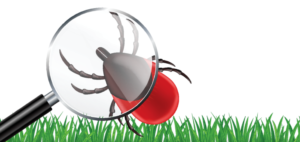Tackle Ticks
Get ahead of ticks by treating your landscape, organically
Ticks are present year-round, but as temperatures warm up and we spend more time outdoors, there is a greater risk of exposure to ticks and tick-borne diseases. Treating your property is an effective way to reduce tick populations and protect you, your family, and pets from the various diseases ticks may carry. Tick-borne diseases range from Lyme disease to babesiosis, ehrlichiosis, Rocky Mountain spotted fever, anaplasmosis, and others.
tick-borne diseases. Treating your property is an effective way to reduce tick populations and protect you, your family, and pets from the various diseases ticks may carry. Tick-borne diseases range from Lyme disease to babesiosis, ehrlichiosis, Rocky Mountain spotted fever, anaplasmosis, and others.
Knowing the habits and life cycle of ticks is important in creating an effective program for your landscape. The spring season is when ticks in their nymph stage begin latching onto small rodents such as mice, chipmunks and squirrels, which then carry the disease-ridden ticks into your yard. There’s a higher chance of being infected by ticks in their nymph state since they are very small and hard to detect.
Where do ticks usually reside?
Ticks generally reside in leaf litter, underbrush and ground cover on your property, but they can be carried onto your lawn too. The ecotone area, the area that divides the yard and the tree line, is a particularly popular home for ticks.
Treat Ticks Organically
SavATree has developed a comprehensive approach that is in sync with the tick life cycle, is environmentally sensible and powerful in its defense. We also offer a two-pronged approach using tick habitat treatments and organic treatments that include cedar oil and raspberry extract. These natural ingredients kill ticks on contact and provide residual control lasting 30-60 days.
How can I minimize my property’s tick population?
In addition to our effective treatments, the best way to minimize the tick population is to keep your property clear of debris, leaf and firewood piles in order to make it physically inhospitable to ticks.
The CDC outlined where ticks are most commonly found:
American dog tick: East of the Rocky Mountains and certain areas on the Pacific Coast.
Blacklegged tick, or deer tick: Eastern U.S.
Brown dog tick: Across the U.S.
Gulf Coast tick: Coastal areas of the U.S., mostly along the Atlantic coast and the Gulf of Mexico.
Lone star tick: Southeastern and Eastern U.S.
Rocky Mountain wood tick: Rocky Mountain states such as Colorado, Idaho, Wyoming, Montana and Utah.
Western blacklegged tick: Pacific coast, most commonly found in California.





